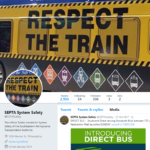Imagine a loved one riding public transport during their daily commute. Perhaps your mother, father, your child, or a friend. It might be a short hop on a light-rail car or a long journey upon a bus. On most days, it can be a quietly packed ride on the way to work or school, filled with familiar faces.
On a daily basis I take transit to and from work. There are moments where I cringe at delays and get frustrated when my cell coverage drops out, but when this happens I like to take the time to look away from my screen and double-check my surroundings.
During these “detached-from-tech” moments, I have witnessed various levels of nuisances and threats on our local light-rail system. Thanks to the many different touch-points I’ve encountered throughout my transit journeys, it was easy to find and contact the appropriate assistance in the moment.
Thinking back to your loved one riding public transportation, do they know what action to take during a situation that may risk their safety, or the safety of others?
Below are great examples of how some of the top 15 public transit authorities in North America*, have used technology driven communications to promote passenger safety.
(*According to the Sustainable Cities Mobility Index.)
Websites

Within the award-winning site, there are examples of suspicious behaviour and tips along with how to report them to the right authority.
Social Media
Most transit authorities extend their online communications beyond their websites to popular social media networks.
Depending on the level of engagement and communication with ridership and the community, some transit authorities may choose Twitter or Facebook.

Calling for Help via Mobile Devices
![[ Texting 87-77-77 to Transit Police in Metro Vancouver ]](https://blog.seon.com/wp-content/uploads/2018/04/IMG_20180302_090121-Transit-Police-SMS-877777-150x150.jpg)
![[ #ThisisWhere campaign and the SafeTTC App via the TTC ]](https://blog.seon.com/wp-content/uploads/2018/04/771633660_orig-ttc-150x150.jpg)
Public Service Announcements about Safety (PSAs)
![[ Dumb Ways to Die Video by Metro Trains Melbourne ]](https://blog.seon.com/wp-content/uploads/2018/04/Dumb-Ways-to-Die-YouTube-150x150.png)
![[ Safetyville. Safety begins with you by Metro Los Angeles ]](https://blog.seon.com/wp-content/uploads/2018/04/Present-or-pulverized-Safety-begins-with-you-YouTube-150x150.png)
Video Surveillance Systems
![[ Chapel Hill Case Study on Transit Safety ]](https://blog.seon.com/wp-content/uploads/2018/04/20160324_193225_resized-672x372-150x150.jpg)
Video surveillance is not only an essential part of the Intelligent Transportation Systems’ (ITS) ecosystem for all transit agencies, it adds to the safety for all passengers, staff and operators, as detailed in our latest case study with Chapel Hill Transit.
What other aspects of communication and technology do you find increases the assurance of safety for all passengers and staff for your transit authority?
As part of the Safe Fleet family, we continue the traditions of our founding entrepreneurs, by shaping fleets across North America with disruptive safety technologies. In the coming months, keep an eye out for the latest tools demoed at local workshops and transit trade shows.
At the end of the day, technology constantly changes and evolves to the ever-growing needs of all transit stakeholders. There are endless tools available for staff and passengers that ensure the transit riding experience is as smooth and safe as possible. Combining various levels of communication and technology together helps the big picture of ensuring staff and passengers are safe.
Keep up-to-date with transit updates by following our Transit showcase page on LinkedIn.



![[ Safety in the métro by stm ]](https://blog.seon.com/wp-content/uploads/2018/04/Safety-in-the-métro-Société-de-transport-de-Montréal-1-too-close-150x150.png)